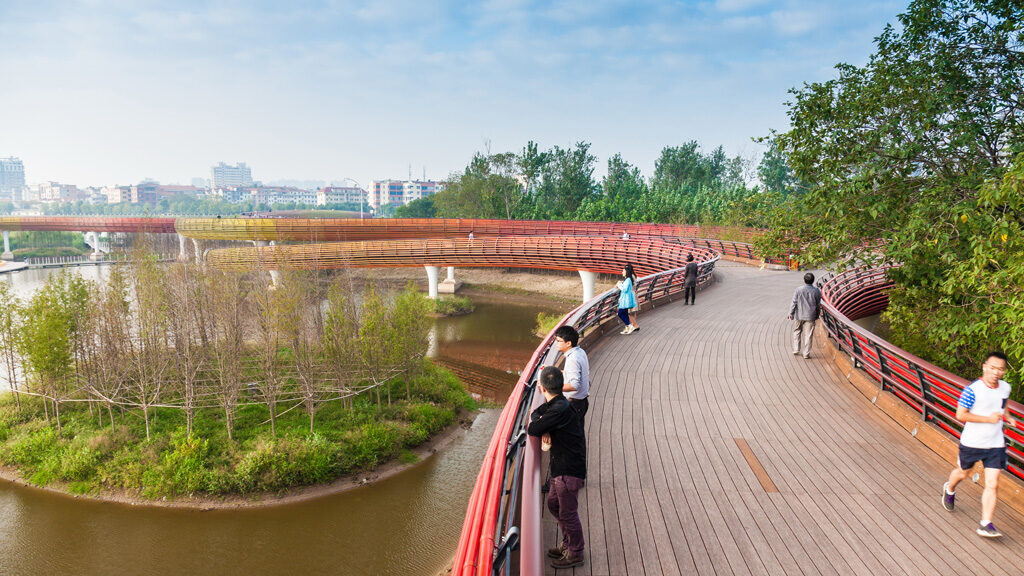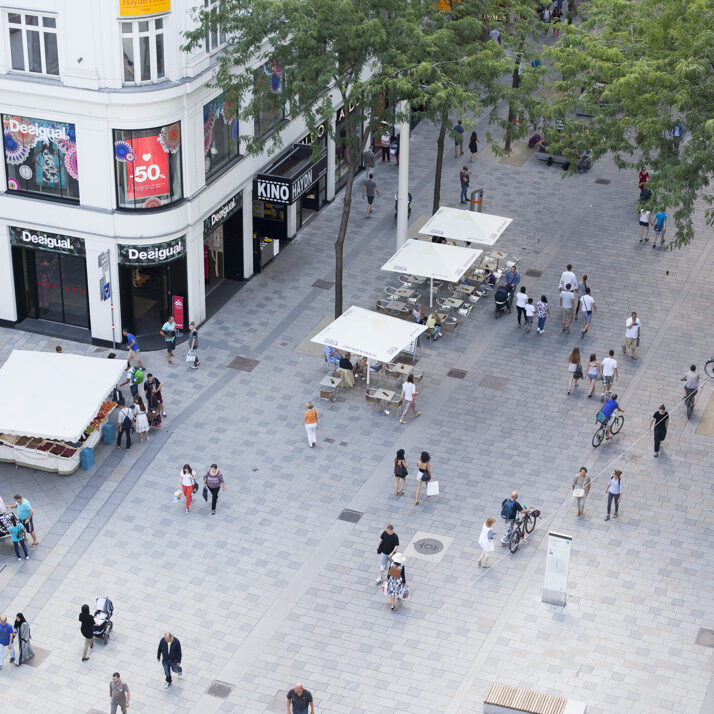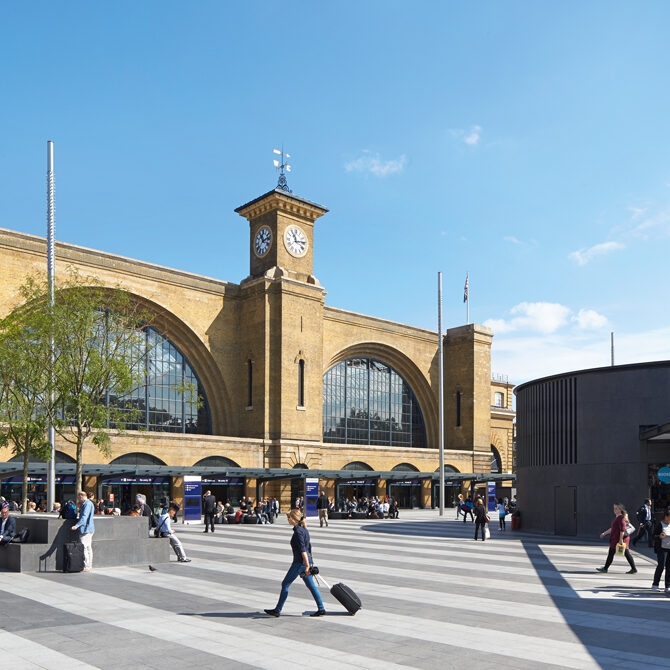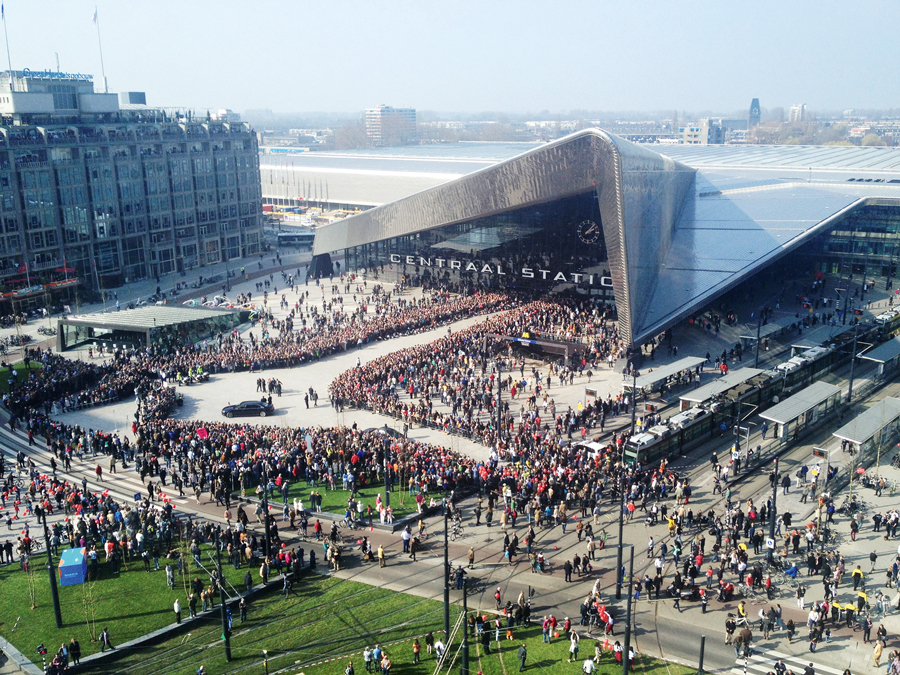
Yanweizhou Park by Turenscape was awarded as World Landscape of the Year 2015. The wetland in China is now dominated by a colorful bridge and adapts to the monsoon floods.
Billboard
Skyscrapper
Halfpage
In the urban heart of Jinhua, a city with a population of over one million, one last piece of natural riparian wetland of more than 64 acres remains undeveloped. Located where the Wuyi River and Yiwu River converge to form Jinhua River, this wetland is called Yanweizhou, meaning “the sparrow tail”. The three rivers divide the densely populated communities in the region. As a result of this inaccessibility, the cultural facilities, including the opera house and the green spaces adjacent to the Yanweizhou, were underutilized. Most of the riparian wetland has been fragmented or destroyed by sand quarries and is now covered with secondary growth.
Due to its monsoon climate, Jinhua suffers from annual flooding. Hard high walls have been built, or were planned to be built, to protect the last patch of riparian wetland (Yanweizhou) from the 20-year and 200-year floods. These floodwalls would create dry parkland above the water, but destroy the lush and dynamic wetland ecosystem. Therefore, we devised a contrasting solution and convinced the city authorities to stop the construction of the concrete floodwall as well as demolish others. Instead, the Yanweizhou Park project “makes friends” with flooding by using a cut-and-fill strategy to balance earthwork and by creating a water-resilient, terraced river embankment that is covered with flood-adapted native vegetation. Floodable pedestrian paths and pavilions are integrated with the planting terraces, which will be closed to the public during the short period of flooding. The floods bring fertile silt that is deposited over the terraces and enriches the growing condition for the tall grasses that are native to the riparian habitat. The terraced embankment will also remediate and filtrate the stormwater from the pavement above. The Yanweizhou Park project showcases a replicable and resilient ecological solution to large-scale flood management.
In addition to the terraced river embankment, the inland area is entirely permeable in order to create a water-resilient landscape through the extensive use of gravel that is re-used material from the site. The gravel is used for the pedestrian areas; the circular bio-swales are integrated with tree planters; and permeable concrete pavement is used for vehicular access routes and parking lots. The inner pond on the inland is designed to encourage river water to infiltrate through gravel layers. This mechanically and biologically improves the water quality to make the water swimmable.
A pedestrian bridge snakes across the rivers, linking the parks along the riverbanks in both the southern and northern city districts, and connecting the city with Yanweizhou Park within the river. The bridge design was inspired by the local tradition of dragon dancing during the Spring Festival. For this celebration, many families bind their wooden benches together to create a long and colorful dragon that winds through the fields and along narrow dirt paths. The Bench Dragon is flexible in length and form as people join or leave the celebration. Like the Bench Dragon during the annual festival, the Bench Dragon Bridge symbolizes not only a form of celebration practiced in the Jinhua area, but is a bond that strengthens a cultural and social identity unique to this region. As water-resilient infrastructure, the new bridge is elevated above the 200-year flood level, while the ramps connecting the riparian wetland park can be submerged during the 20-year and larger floods. The bridge also hovers above the preserved patch of riparian wetland and allows visitors an intimate connection to nature. The many ramps to the bridge create flexible and easy access for residents from various locations of the city in adaptation to the flow of people. Reaching a total length of 2.300 feet, the bridge is composed of a steel structure with fiberglass handrails and bamboo paving. It is truly a resilient bridge that is adaptive to river currents and the flows of people, while binding city and nature, future and past. […]
After the park opened in May 2014, an average of 40.000 visitors used the park and the bridge each day. It was recently awarded the World Landscape of the Year 2015.
Read the full article in Topos 90 – Resilient Cities and Landscapes.























